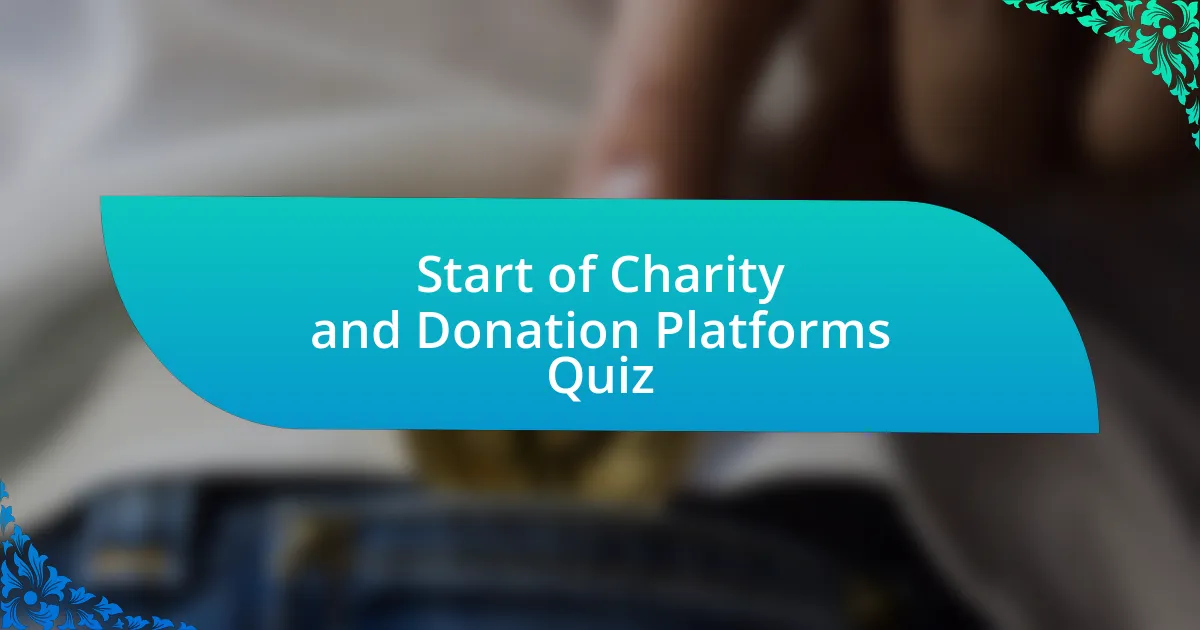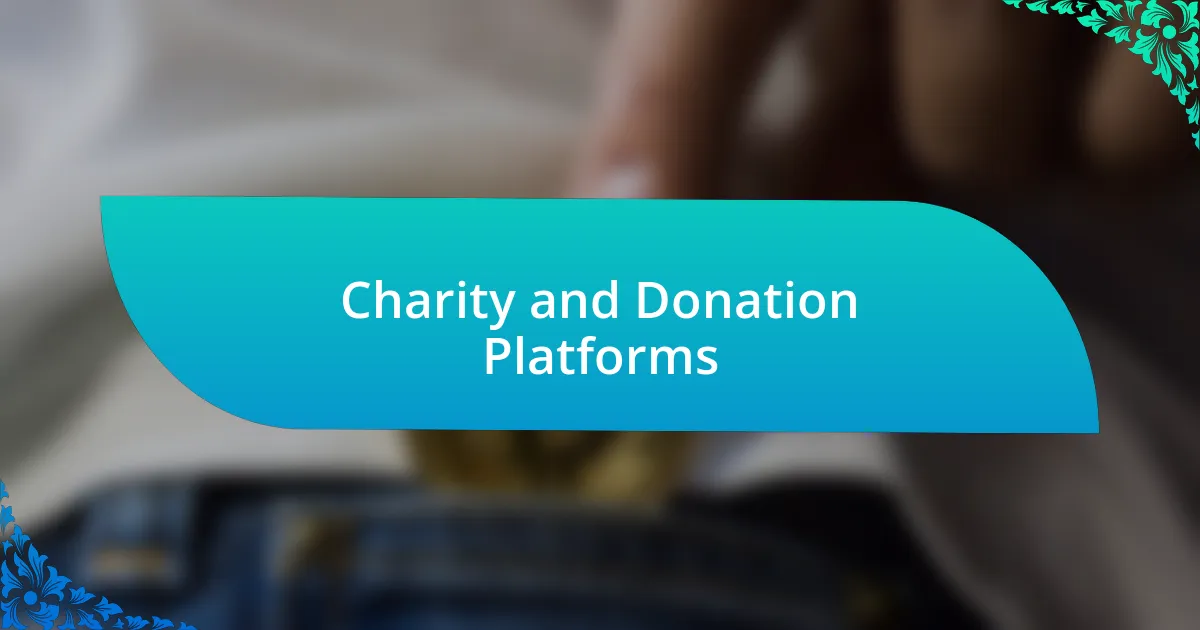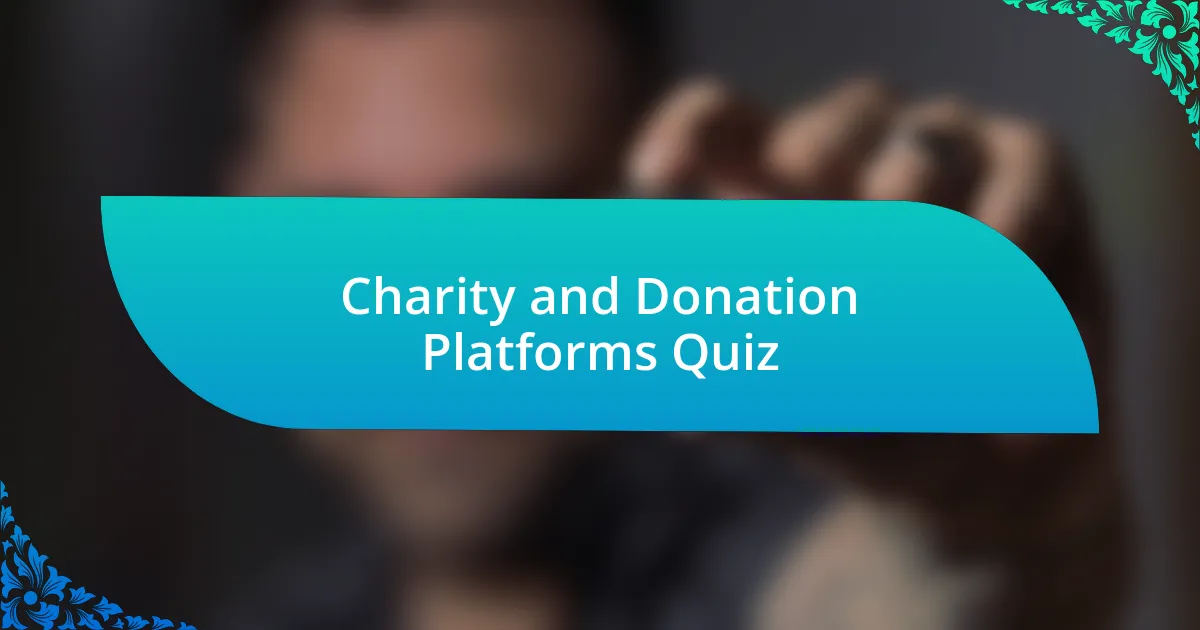
Start of Charity and Donation Platforms Quiz
1. What is a common Ethereum-based platform for raising funds for charities?
- Giveth
- Indiegogo
- Fundly
- GoFundMe
2. How can Ethereum smart contracts be utilized in donation platforms?
- Ethereum smart contracts allow for traditional bank transfers.
- Ethereum smart contracts are used for social media networking.
- Ethereum smart contracts can automate donation processing and tracking.
- Ethereum smart contracts can replace physical cash transactions.
3. What is the benefit of using Ethereum for cross-border charitable donations?
- Reduced transaction costs and faster transfers
- Increased paperwork and slower transfers
- Less transparency in donations
- Limited access for international donors
4. Which cryptocurrency is commonly used on charity-focused Ethereum platforms?
- Dogecoin
- Ripple
- Gitcoin
- Litecoin
5. What unique feature do Ethereum-based platforms offer for donor verification?
- Automatic tax deductions
- Pre-selected donation amounts
- Unlimited donor rewards
- Transparent donation tracking
6. How does transparency play a role in Ethereum charity platforms?
- Transparency reduces the efficiency of transactions on Ethereum charity platforms.
- Transparency creates confusion about the donation process on Ethereum charity platforms.
- Transparency limits donor engagement and communication on Ethereum charity platforms.
- Transparency ensures public trust in Ethereum charity platforms by allowing donors to track fund usage and impact.
7. What type of donation tracking can be enhanced by using Ethereum blockchain?
- Loan tracking
- Real estate management
- Merchandise sales
- Donation transparency
8. Which Ethereum project aims to streamline the donation process for nonprofits?
- Fundly
- CrowdRise
- StartSomeGood
- Giveth
9. How can Ethereum increase the efficiency of fundraising campaigns?
- Ethereum requires cash transactions for fundraising.
- Ethereum raises funds with traditional bank transfers.
- Smart contracts automate donations on Ethereum.
- Ethereum uses physical checks for donations.
10. What is a primary advantage of using tokenization in charity donations on Ethereum?
- Limited usability on mobile devices
- Higher fees for transactions
- Increased risk of fraud
- Increased transparency in donations
11. How do Ethereum-based platforms handle transaction fees for charitable donations?
- Ethereum-based platforms automatically waive transaction fees for all charitable organizations.
- Ethereum-based platforms typically charge transaction fees that vary based on network congestion.
- Ethereum-based platforms only accept donations in fiat currencies without any fees.
- Ethereum-based platforms offer zero transaction fees for all donations.
12. What role do decentralized autonomous organizations (DAOs) play in Ethereum charity?
- DAOs serve as traditional banks for handling donations in Ethereum charity.
- DAOs manage offline fundraising events in Ethereum charity.
- DAOs act as government bodies overseeing charitable activities in Ethereum charity.
- DAOs facilitate transparent fund allocation and decision-making in Ethereum charity.
13. Why might nonprofits choose an Ethereum platform over traditional donation methods?
- Higher operational costs for nonprofits
- Poor visibility into donation tracking
- Limited payment options for donors
- Lower transaction fees and increased transparency
14. What is a potential drawback of using Ethereum for charity and donations?
- High transaction fees
- Complete anonymity
- Instant transactions
- Unlimited donation amounts
15. How can Ethereum facilitate peer-to-peer crowdfunding for charitable causes?
- Ethereum utilizes smart contracts for transparent crowdfunding.
- Ethereum is primarily a social media platform for charities.
- Ethereum only supports traditional bank transactions without innovation.
- Ethereum focuses solely on real estate investments, not crowdfunding.
16. What is the significance of using ERC-20 tokens in Ethereum philanthropy?
- They are only relevant to gaming applications.
- They are used for initial coin offerings only.
- They increase the cost of transactions significantly.
- They enable secure and transparent donations.
17. How does Ethereum improve accountability in charitable contributions?
- It employs AI to predict donation trends.
- It uses blockchain to provide transparent transaction records.
- It mandates third-party audits for all donations.
- It requires anonymous donations to increase trust.
18. Which Ethereum solution supports micro-donations for charities?
- Classy
- DonorBox
- Fundly
- Giveth
19. What impact does Ethereum`s scalability have on charity campaigns?
- It decreases the visibility of charity campaigns online.
- It makes donations anonymous, hindering accountability.
- It allows for quicker and cheaper transactions, increasing overall donations.
- It limits the types of currencies accepted for donations.
20. How can Ethereum-based platforms enable instant donation confirmations?
- Ethereum uses smart contracts for instant confirmations.
- Ethereum relies on traditional banking systems.
- Ethereum uses third-party payment processors.
- Ethereum requires manual transaction verification.
21. What type of fundraising events can benefit from Ethereum technology?
- Local bake sales
- Charity car washes
- Crowdfunding campaigns
- Raffle ticket sales
22. How can NFT technology intersect with charity donations on Ethereum?
- NFTs can only be held by the donors on Ethereum.
- NFTs can be used to purchase physical goods for charities on Ethereum.
- NFTs can decrease charity donations on Ethereum.
- NFTs can be sold with proceeds donated to charities on Ethereum.
23. What is the role of community engagement in Ethereum charity initiatives?
- Community engagement reduces transparency in donations.
- Community engagement helps raise awareness and support for charity initiatives.
- Community engagement is unnecessary for funding distribution.
- Community engagement focuses solely on marketing strategies.
24. Can Ethereum platforms offer tax advantages for donors?
- Yes, Ethereum platforms can offer tax advantages for donors.
- Ethereum platforms have no relevance to tax benefits for donors.
- No, Ethereum platforms cannot offer tax advantages for donors.
- Only Bitcoin platforms can offer tax advantages for donors.
25. How does Ethereum support social impact projects through strategic partnerships?
- Ethereum collaborates with organizations to enhance social impact projects.
- Ethereum does not engage in any partnerships.
- Ethereum primarily supports gaming projects.
- Ethereum only focuses on cryptocurrency trading.
26. What are the security benefits of using Ethereum for charitable transactions?
- Transactions can be reversed easily to resolve disputes instantly.
- Ethereum prevents all fraud by eliminating all intermediaries.
- Transactions are secure and transparent due to blockchain technology.
- Ethereum stores sensitive personal data on a centralized server.
27. How does Ethereum guarantee the immutability of donation records?
- Through manual record keeping
- Through blockchain technology
- By using traditional banks
- By relying on government oversight
28. In what ways can smart contracts enhance donor incentives for charities?
- Smart contracts can improve social media awareness.
- Smart contracts can increase the number of volunteers.
- Smart contracts can provide transparency in donations.
- Smart contracts can reduce the amount of funds needed.
29. What is a key factor in donor retention for Ethereum-based charity platforms?
- High fees on transactions
- Transparency in operations
- Limited donation options
- Lack of user-friendly interface
30. How can data analytics improve fundraising strategies on Ethereum platforms?
- Data analytics can identify donor trends and optimize campaign strategies.
- Data analytics is only useful for charity event planning.
- Data analytics only helps in managing cryptocurrency transactions.
- Data analytics has no effect on fundraising at all.

Congratulations! You’ve Completed the Quiz
Well done on finishing the quiz about Charity and Donation Platforms! This exercise not only tested your knowledge but also broadened your understanding of the various ways people can support causes they care about. It’s fascinating to see how these platforms connect donors with organizations and individuals in need. You’ve gained insights into different charitable approaches and the importance of community support.
Throughout the quiz, you may have discovered how technology is shaping the landscape of philanthropy. Learning about the various platforms available and their unique features can empower you to contribute effectively. Whether you’re interested in monetary donations, volunteering, or in-kind support, this new knowledge can help you make informed choices about where and how to contribute.
We invite you to explore the next section on this page for more comprehensive information about Charity and Donation Platforms. This resource will enhance your understanding further and provide you with practical guidance on making a difference in your community. Dive in and continue your journey of learning and engagement in the world of charity!

Charity and Donation Platforms
Overview of Charity and Donation Platforms
Charity and donation platforms are online services that facilitate contributions to various causes. They connect donors with organizations seeking funding. These platforms often allow users to browse campaigns, make donations, and track their contributions. They play a crucial role in nonprofit fundraising by democratizing access to charitable giving. The rise of digital technology has made these platforms increasingly popular, enhancing visibility for causes and simplifying the donation process.
Types of Charity and Donation Platforms
There are several types of charity and donation platforms, including crowdfunding sites, charity-specific platforms, and general fundraising platforms. Crowdfunding platforms enable individuals to raise money for personal causes or projects, while charity-specific platforms focus on particular organizations or missions. General fundraising platforms may support multiple charities or campaigns, providing flexibility for donors. Each type serves unique needs, guiding donors towards their preferred causes.
Features of Effective Charity and Donation Platforms
An effective charity and donation platform typically includes features such as user-friendly interfaces, secure payment options, and transparency in fundraising. User-friendly interfaces ensure easy navigation for donors. Secure payment options are critical for protecting sensitive financial information. Transparency in fundraising activities, such as detailed project descriptions and financial reports, builds trust with potential donors. These features enhance user experience and encourage more people to donate.
Impact of Charity and Donation Platforms on Philanthropy
Charity and donation platforms significantly impact philanthropy by expanding reach and increasing accessibility. They enable organizations to engage with a broader audience and attract donations from diverse demographics. Online visibility and marketing tools allow causes to spread awareness quickly, often leading to increased funding. As a result, these platforms play a vital role in fostering a culture of giving and philanthropy in society.
Challenges Faced by Charity and Donation Platforms
Charity and donation platforms face several challenges, including competition, regulatory compliance, and trust issues. Competition among platforms can lead to donor fatigue, making it challenging for new initiatives to gain attention. Regulatory compliance is essential to ensure that funds are managed legally and ethically. Trust issues may arise from fraud cases or mismanagement of funds, which can deter potential donors. Addressing these challenges is crucial for the sustainability and growth of these platforms.
What are Charity and Donation Platforms?
Charity and donation platforms are online services that facilitate the process of giving to charitable organizations and causes. They enable individuals and businesses to donate money, time, or resources to a variety of nonprofit entities. These platforms often provide features like crowdfunding capabilities, transparency about fund allocation, and options for recurring donations. In 2021, online charitable giving in the U.S. amounted to over $400 billion, demonstrating their importance in modern philanthropy.
How do Charity and Donation Platforms work?
Charity and donation platforms work by connecting donors with nonprofit organizations through a digital interface. Donors can browse various causes, read about the projects, and make contributions via credit card, bank transfer, or other methods. The platforms usually take a small fee from each transaction to operate. According to data from Nonprofit Source, 30% of all fundraising is done online, illustrating the effectiveness of these platforms.
Where can I find Charity and Donation Platforms?
You can find charity and donation platforms on the internet through search engines, social media, or recommendations from friends. Popular platforms include GoFundMe, Kickstarter for social projects, and JustGiving. These platforms are accessible via their websites or mobile applications. A report from Statista indicates that over 60% of American adults have donated to charity online, reflecting the widespread use of these platforms.
When should I use Charity and Donation Platforms?
You should use charity and donation platforms when you wish to support philanthropic causes, especially if you prefer quick and transparent transactions. They are particularly useful during fundraising campaigns, disaster relief efforts, and community projects. The rise of online giving has seen a 20% increase in donations during the holiday season, indicating a strategic time to engage with these platforms.
Who can benefit from Charity and Donation Platforms?
Individuals, nonprofit organizations, and communities can benefit from charity and donation platforms. Donors gain a simple way to support meaningful causes. Nonprofits gain wider visibility and access to funds, allowing for project development. A study by Blackbaud in 2020 reported that organizations using online platforms raised, on average, 32% more funds compared to those that did not. This shows the significant advantages for both donors and recipients.

